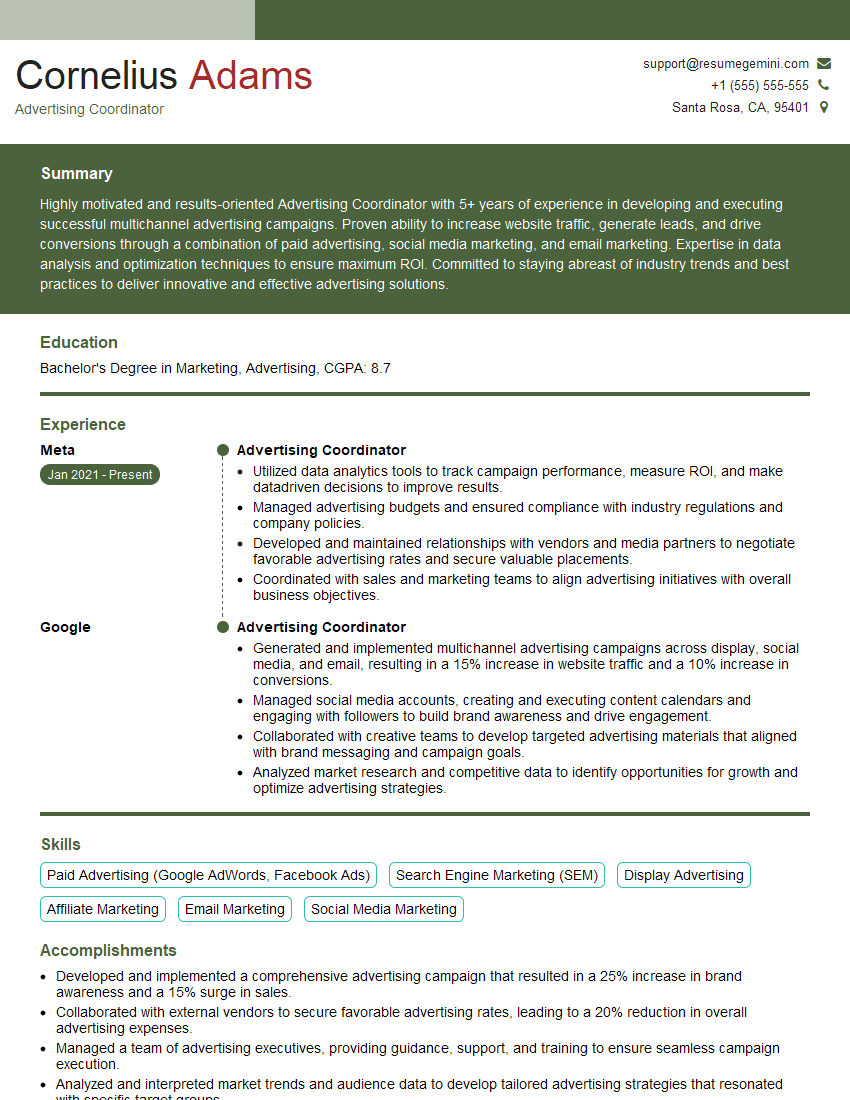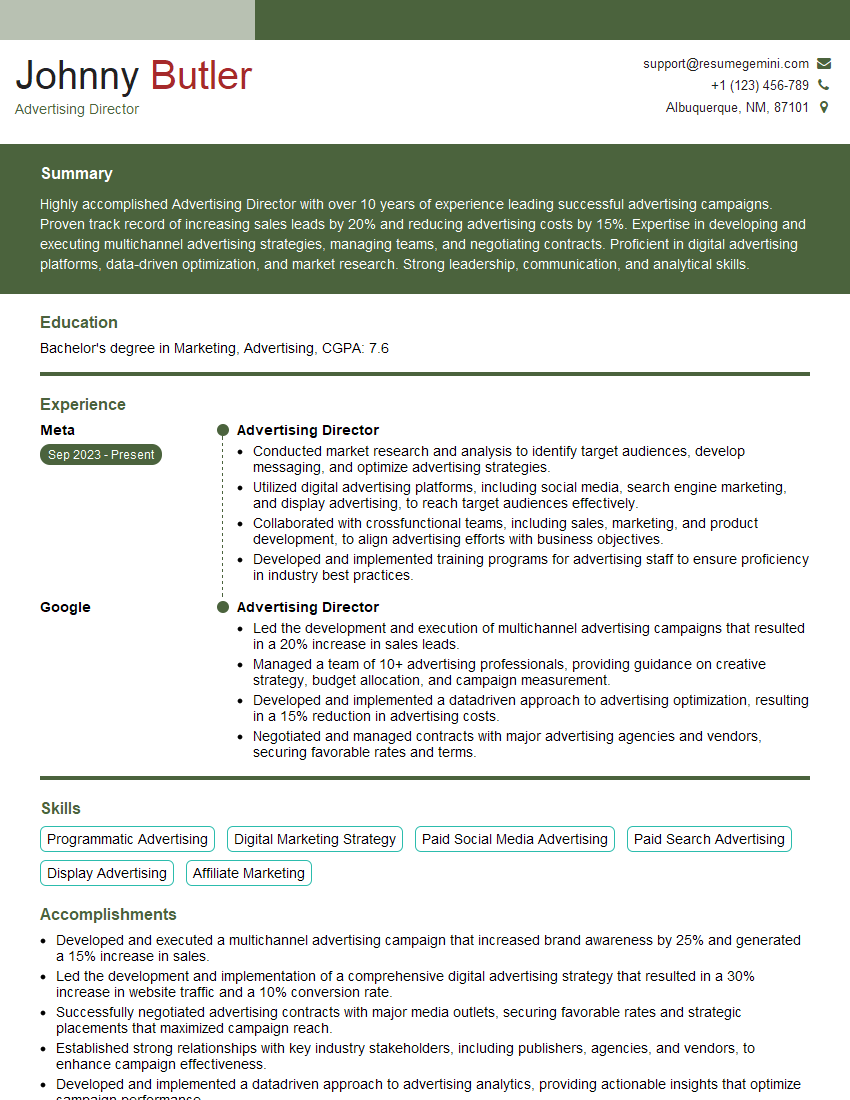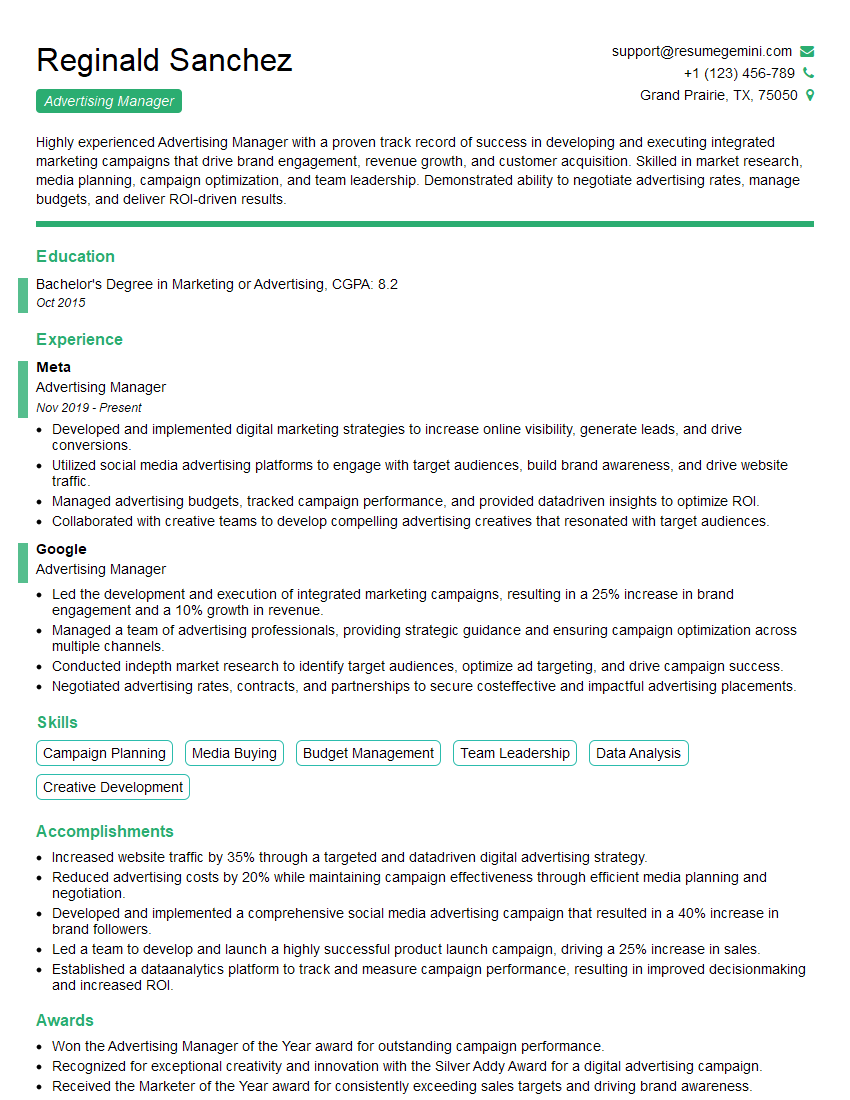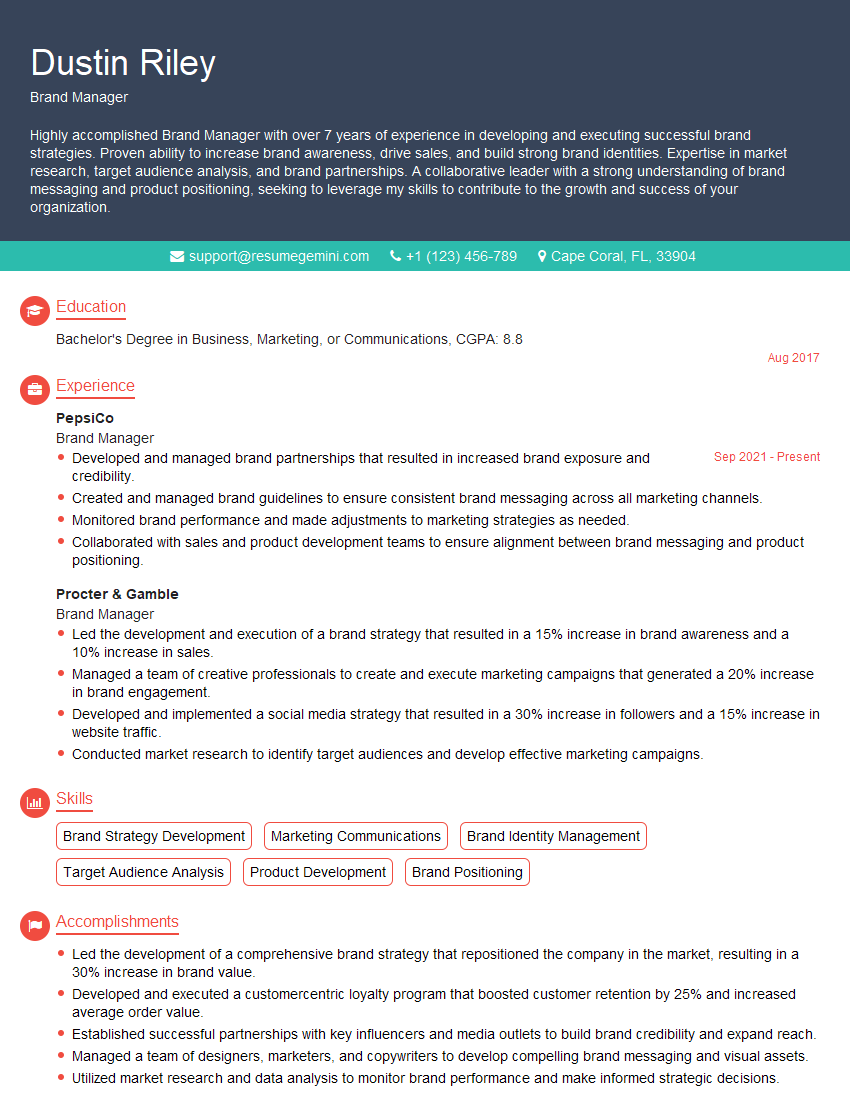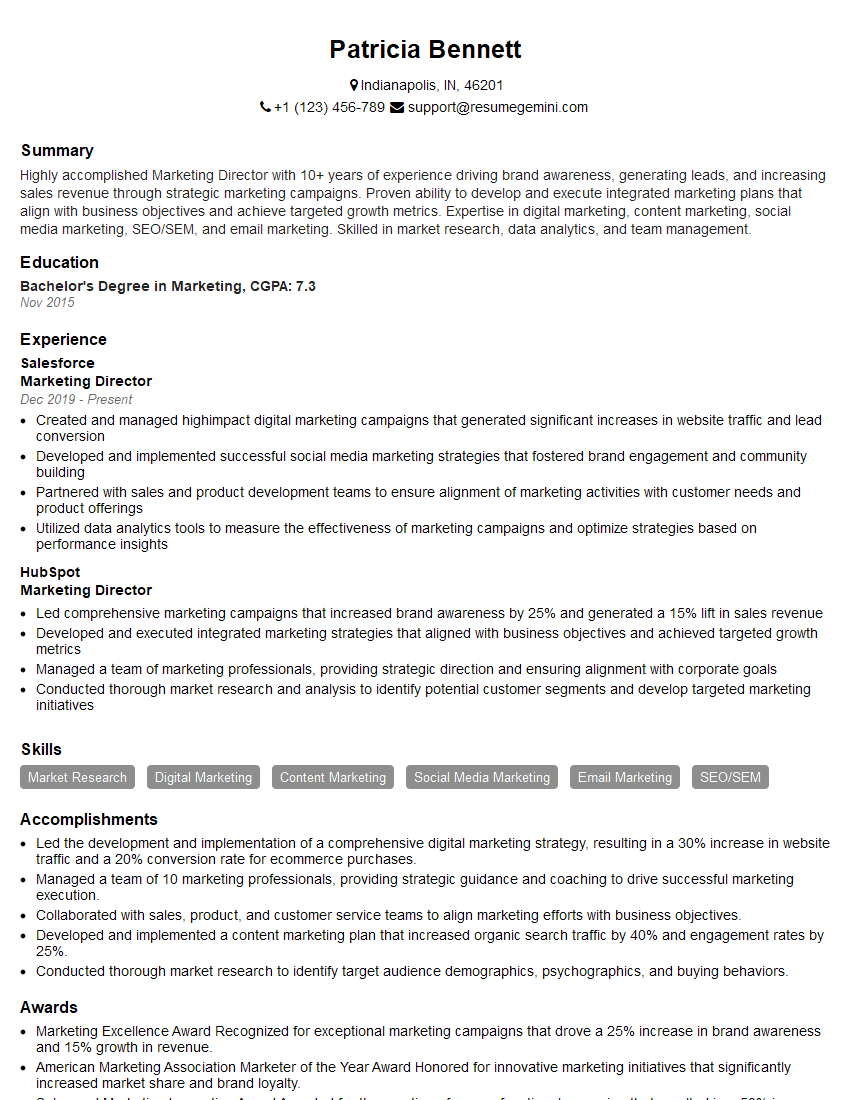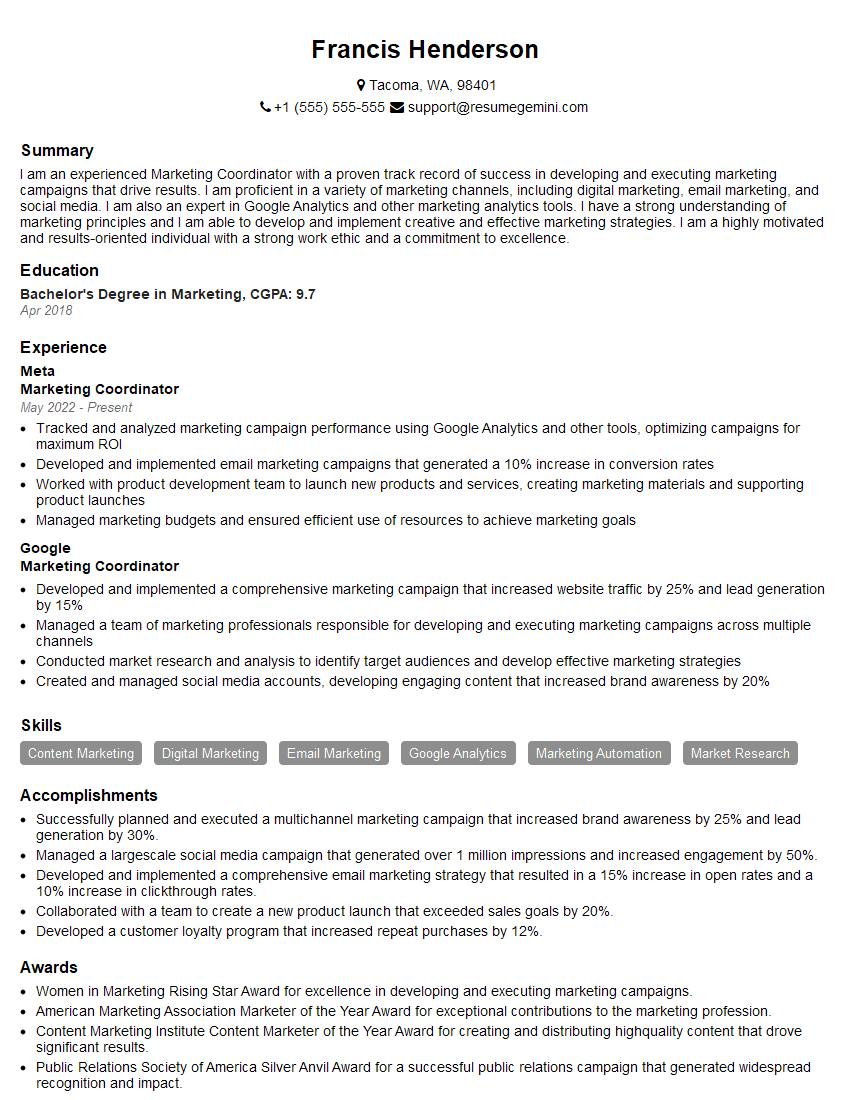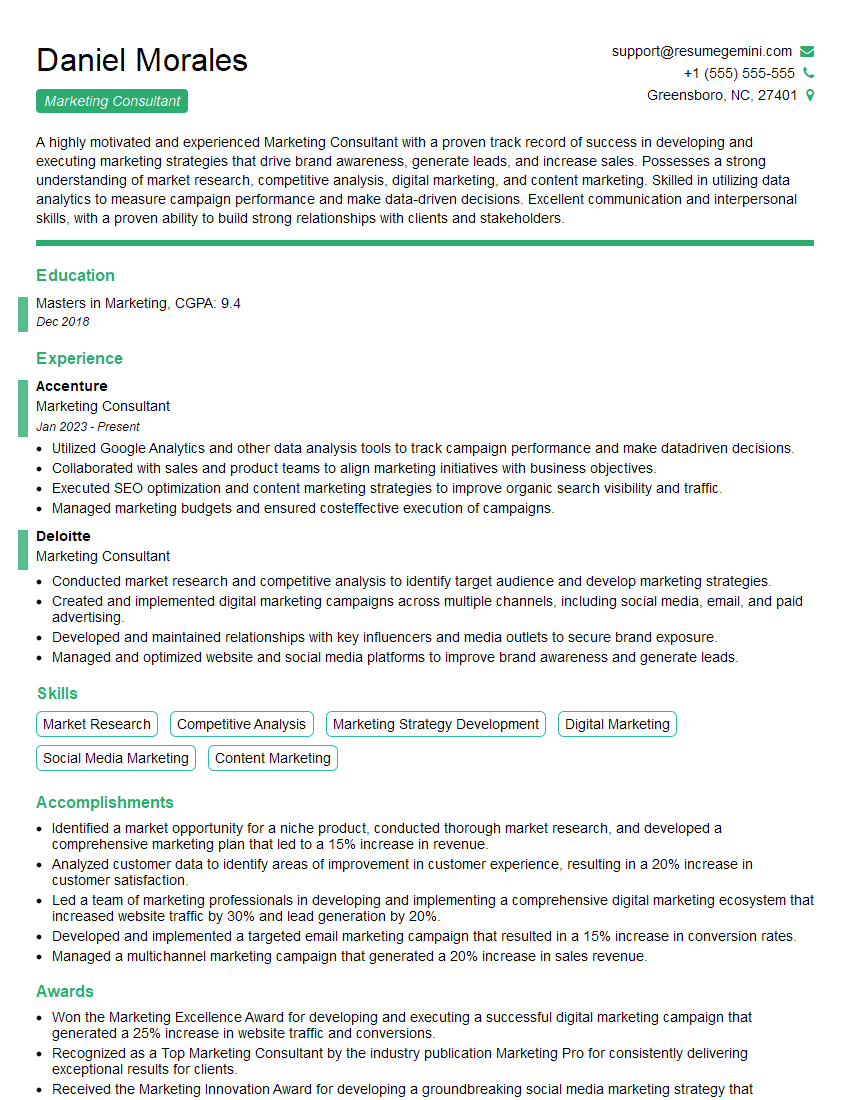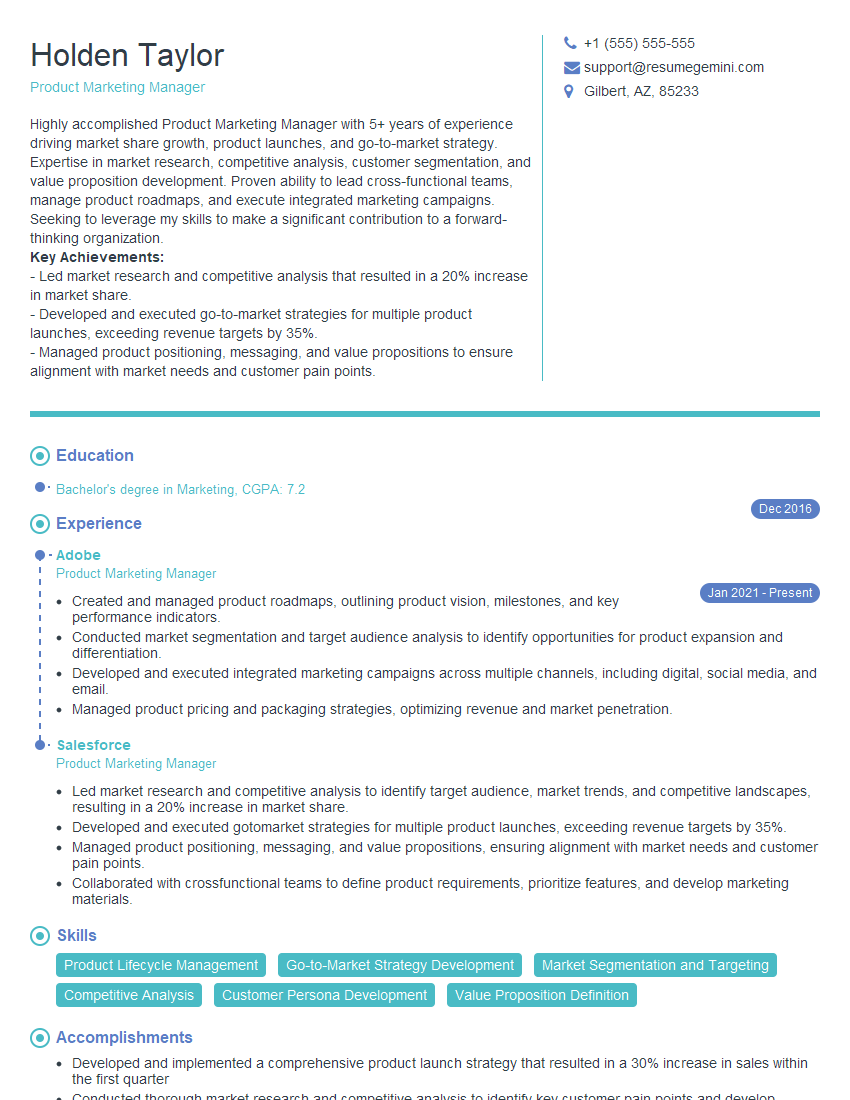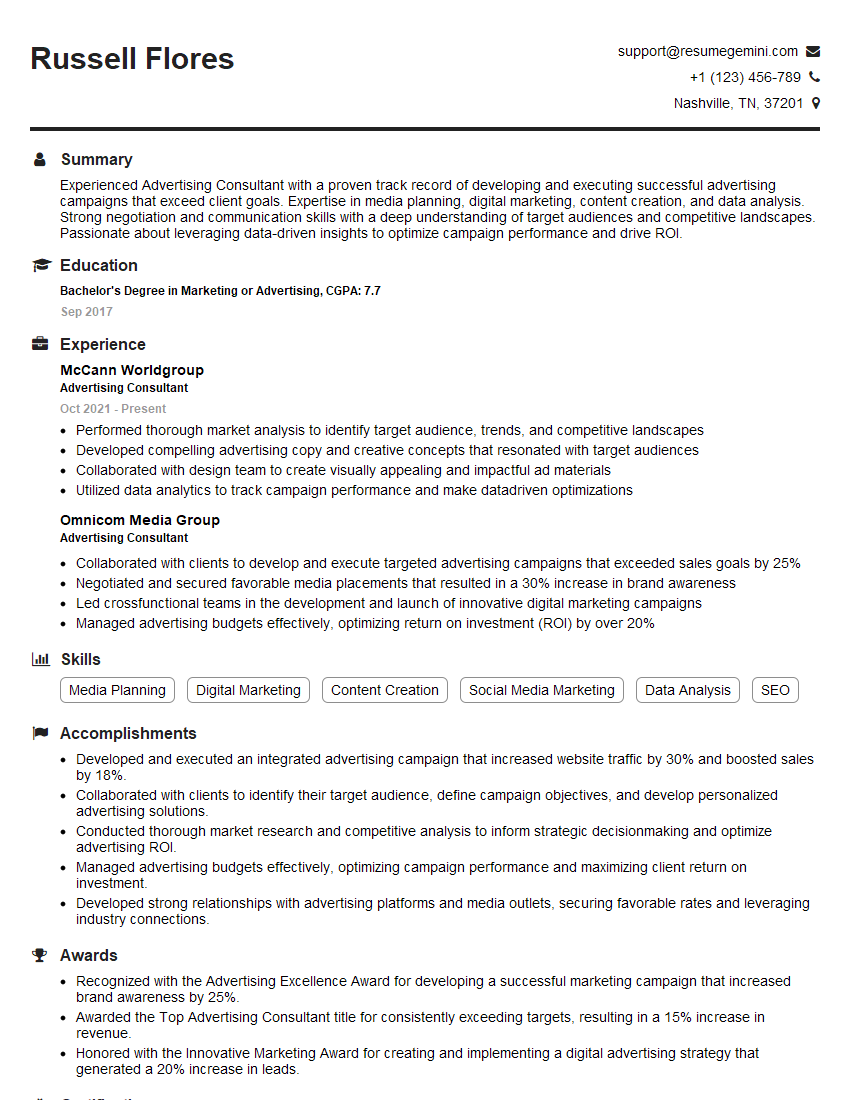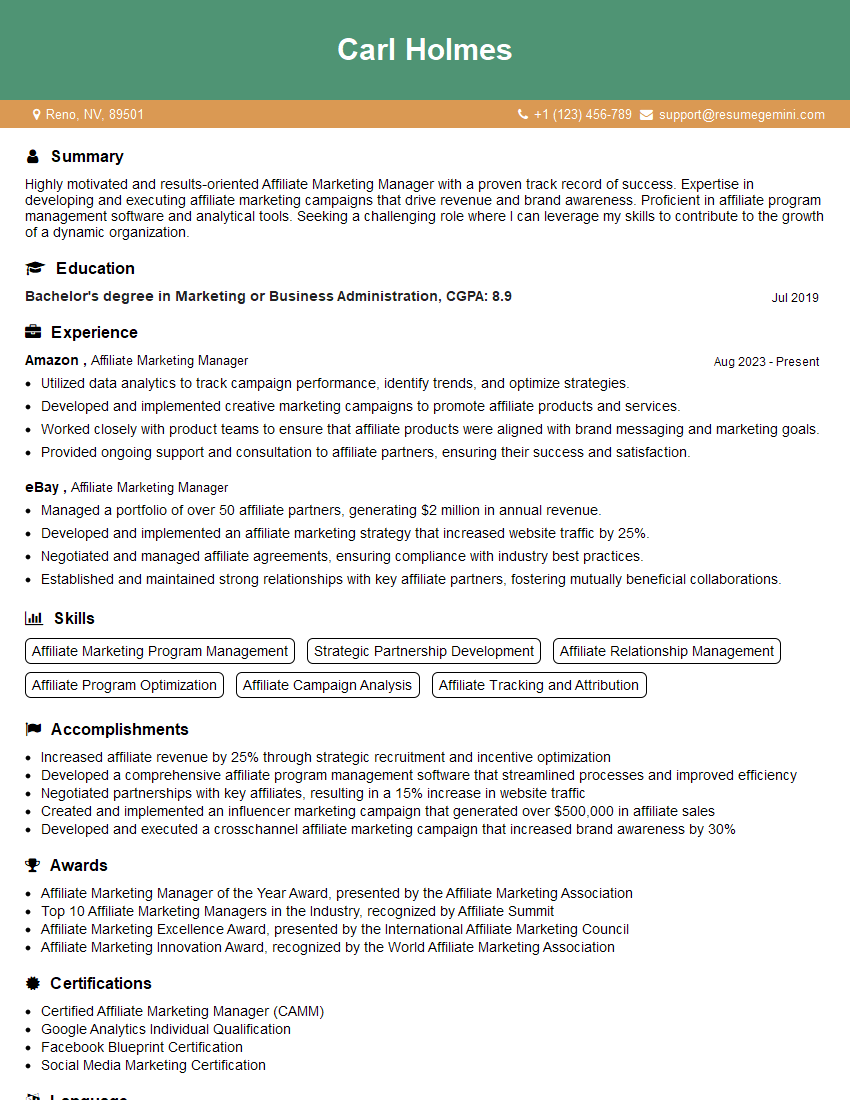Cracking a skill-specific interview, like one for Experience in marketing and advertising., requires understanding the nuances of the role. In this blog, we present the questions you’re most likely to encounter, along with insights into how to answer them effectively. Let’s ensure you’re ready to make a strong impression.
Questions Asked in Experience in marketing and advertising. Interview
Q 1. Explain your experience with different marketing channels (e.g., SEO, SEM, social media).
My experience spans a wide range of marketing channels, each with its own strengths and nuances. I’ve successfully managed campaigns across SEO (Search Engine Optimization), SEM (Search Engine Marketing), and various social media platforms.
In SEO, I focus on optimizing website content and structure to improve organic search rankings. This involves keyword research, on-page optimization (title tags, meta descriptions, header tags), and off-page optimization (link building, content marketing). For example, I recently boosted a client’s organic traffic by 40% in six months by implementing a comprehensive SEO strategy focusing on long-tail keywords and high-quality content.
SEM, or paid search advertising, allows for more immediate results. I’ve managed campaigns on platforms like Google Ads, utilizing various targeting options (keywords, demographics, interests) to reach specific audiences. A recent SEM campaign resulted in a 25% increase in qualified leads within a quarter.
Regarding social media, my expertise includes developing and executing strategies across platforms like Facebook, Instagram, Twitter, and LinkedIn. This involves creating engaging content, running targeted ad campaigns, and monitoring social listening to understand audience sentiment. For instance, a social media campaign I ran for a small business increased brand awareness by 60% and generated a significant increase in customer engagement.
Q 2. Describe your process for developing a marketing strategy.
Developing a marketing strategy is a meticulous process. It begins with a deep understanding of the business goals and target audience. My process typically follows these steps:
- Market Research & Analysis: This involves understanding the competitive landscape, target audience demographics, psychographics, and their online behavior. Tools like Google Analytics and social media analytics are crucial here.
- Defining Objectives & KPIs: Clearly defining SMART (Specific, Measurable, Achievable, Relevant, Time-bound) goals is paramount. This could involve increasing website traffic, generating leads, boosting sales, or enhancing brand awareness. Key Performance Indicators (KPIs) are established to track progress towards these objectives.
- Target Audience Identification: Creating a detailed ideal customer profile (ICP) helps tailor messaging and channel selection. This involves understanding their needs, pain points, and preferred communication channels.
- Channel Selection: Choosing the right marketing channels depends on the target audience and marketing objectives. This could involve SEO, SEM, social media, email marketing, content marketing, or a combination of these.
- Content Strategy & Creation: Developing compelling and relevant content is vital for engaging the target audience. This could involve blog posts, social media updates, email newsletters, videos, or infographics.
- Budget Allocation & Campaign Management: Allocating resources across different channels requires careful planning and ongoing monitoring. Campaign management involves tracking progress, making adjustments as needed, and optimizing for maximum ROI.
- Analysis & Reporting: Regular monitoring and reporting on KPIs are crucial for evaluating campaign performance and making data-driven decisions.
This structured approach ensures a cohesive and effective marketing strategy aligned with the business objectives.
Q 3. How do you measure the success of a marketing campaign?
Measuring the success of a marketing campaign requires a clear understanding of the initial objectives and KPIs. There isn’t a one-size-fits-all approach, but a combination of metrics is usually necessary.
Common metrics include:
- Website Traffic & Engagement: Analyzing website traffic sources, bounce rate, time on site, and pages per visit provides insights into audience engagement.
- Lead Generation: Tracking the number of leads generated, their quality, and conversion rates are crucial for evaluating the effectiveness of lead generation campaigns.
- Sales & Revenue: Measuring sales revenue directly attributed to marketing campaigns is the ultimate measure of success.
- Brand Awareness & Sentiment: Monitoring social media mentions, brand searches, and customer reviews provides insights into brand perception.
- Return on Investment (ROI): Calculating the ROI of marketing campaigns helps assess the return on investment and optimize future campaigns.
For example, a successful social media campaign might show a significant increase in website traffic from social media channels, a high engagement rate on posts, and a noticeable increase in leads.
Q 4. What are your favorite marketing analytics tools?
I utilize a suite of marketing analytics tools to gain a comprehensive understanding of campaign performance. Some of my favorites include:
- Google Analytics: An indispensable tool for tracking website traffic, user behavior, and conversion rates.
- Google Ads: Provides detailed performance data for paid search campaigns, including keyword performance, click-through rates, and conversion rates.
- Social Media Analytics (Facebook Insights, Twitter Analytics, etc.): Offer valuable insights into social media audience engagement, reach, and campaign performance.
- SEMrush or Ahrefs: SEO tools that provide keyword research, competitor analysis, and website audit capabilities.
- Google Data Studio or Tableau: Data visualization tools that allow for creating custom dashboards to track key metrics and present data effectively.
The choice of tools depends on the specific needs of the campaign and the overall marketing strategy.
Q 5. Explain your understanding of the customer journey.
The customer journey is the process a customer goes through from initial awareness of a brand to becoming a loyal advocate. Understanding this journey is crucial for creating effective marketing strategies. I visualize it as a series of stages:
- Awareness: The customer becomes aware of a product or brand through various channels (e.g., social media, advertising, word-of-mouth).
- Consideration: The customer researches the product or brand, compares options, and evaluates its value proposition.
- Decision: The customer makes a purchase decision based on their research and evaluation.
- Action: The customer makes a purchase and begins using the product or service.
- Loyalty: The customer becomes a loyal customer and potentially an advocate for the brand.
Mapping the customer journey helps identify touchpoints where marketers can influence the customer’s decision-making process and create personalized experiences. For instance, we might tailor our messaging and offer different content at each stage of the journey.
Q 6. How do you identify and target your ideal customer profile?
Identifying the ideal customer profile (ICP) is a critical step in targeted marketing. It’s about defining the characteristics of your most valuable customers. My approach involves:
- Analyzing Existing Customer Data: Examining existing customer data (CRM, sales data, website analytics) to identify common traits, behaviors, and demographics of high-value customers.
- Market Research: Conducting surveys, interviews, and focus groups to gather insights into potential customer needs, preferences, and pain points.
- Competitive Analysis: Studying competitors’ target audiences to identify potential overlaps and unique opportunities.
- Creating Personas: Developing detailed personas representing the ideal customer, including demographics, psychographics, needs, goals, and online behavior.
For example, if we’re marketing a high-end skincare product, our ICP might be women aged 35-55 with a higher disposable income who are active on social media platforms like Instagram and prioritize natural and organic products. Once we have a clear ICP, we can tailor our messaging, channel selection, and content creation to resonate with this specific group.
Q 7. Describe your experience with A/B testing and optimization.
A/B testing, also known as split testing, is a crucial optimization method. It involves creating two versions of a marketing element (e.g., headline, image, call-to-action) and comparing their performance to determine which performs better. This data-driven approach helps refine campaigns and improve conversion rates.
My experience with A/B testing encompasses various aspects of marketing, including:
- Website Optimization: Testing different website elements (headlines, images, calls to action) to improve conversion rates and user engagement.
- Email Marketing: Testing subject lines, email content, and calls to action to improve open rates, click-through rates, and conversions.
- Social Media Ads: Testing different ad creatives, targeting options, and calls to action to optimize ad performance and reduce costs.
For instance, I recently ran an A/B test on email subject lines for a client. One subject line focused on benefits while the other emphasized urgency. The urgency-focused subject line yielded a 20% higher open rate. The results of A/B tests inform future campaigns, leading to continuous improvement and optimized performance.
Q 8. How do you manage a marketing budget?
Managing a marketing budget effectively requires a strategic approach that balances resource allocation with achieving campaign goals. It starts with a clear understanding of the overall marketing objectives and the key performance indicators (KPIs) that will measure success. I typically begin by creating a detailed budget breakdown, allocating funds across different channels based on their projected ROI (Return on Investment).
- Defining Objectives & KPIs: Before allocating any funds, it’s crucial to define specific, measurable, achievable, relevant, and time-bound (SMART) goals. For example, increasing website traffic by 20% in the next quarter or generating 500 qualified leads. The chosen KPIs will directly influence budget allocation.
- Channel Allocation: I meticulously analyze each marketing channel – be it paid advertising (PPC), social media marketing, content marketing, email marketing, or SEO – considering its potential reach, audience targeting capabilities, and cost-effectiveness. For instance, if the target demographic is highly active on Instagram, a larger portion of the budget might be allocated to Instagram advertising.
- Tracking & Optimization: Continuous monitoring and analysis are paramount. I use analytics tools to track campaign performance against the established KPIs, allowing for adjustments and optimizations throughout the campaign. This includes regularly reviewing campaign data, identifying underperforming channels or strategies, and reallocating funds to maximize ROI. For instance, if a particular PPC campaign is underperforming, I would analyze its keywords, targeting, and ad copy to improve its efficiency.
- Contingency Planning: It’s vital to include a contingency buffer in the budget to account for unforeseen circumstances or opportunities. This flexibility allows for swift responses to market changes or unexpected spikes in demand.
For example, in a previous role, I managed a $50,000 marketing budget for a SaaS company. By carefully tracking campaign performance and reallocating funds based on data insights, we exceeded our lead generation goals by 15% while staying within the allocated budget.
Q 9. How do you stay up-to-date on the latest marketing trends?
Staying abreast of the ever-evolving marketing landscape requires a multifaceted approach. It’s not just about reading articles; it’s about actively engaging with the industry and fostering a culture of continuous learning.
- Industry Publications & Blogs: I regularly read industry-leading publications like MarketingProfs, Adweek, and Search Engine Journal to keep up with the latest trends and best practices. This provides a broad overview of current strategies and innovations.
- Conferences & Webinars: Attending industry conferences and webinars provides invaluable insights from leading experts, offers networking opportunities, and allows for firsthand exposure to emerging technologies and strategies. For instance, attending conferences like SXSW or INBOUND provides crucial networking and learning opportunities.
- Following Influencers & Thought Leaders: I follow prominent marketing influencers on social media platforms like LinkedIn and Twitter, engaging with their content and participating in relevant discussions. This provides exposure to diverse perspectives and emerging ideas.
- Experimentation & Testing: Rather than passively consuming information, I actively test and experiment with new marketing strategies and technologies. This hands-on approach provides practical insights and allows me to assess the effectiveness of novel approaches firsthand. For example, I might try a new social media platform or test a different advertising format.
- Data Analysis & Competitive Research: I use analytics tools to track the performance of my own marketing campaigns and also analyze the strategies of competitors. Understanding what works (and what doesn’t) within the competitive landscape informs my approach.
Essentially, it’s a continuous process of learning, adapting, and refining my strategies based on the latest industry developments and data-driven insights.
Q 10. What is your experience with content marketing?
Content marketing is the cornerstone of many successful marketing strategies. My experience encompasses the entire content lifecycle, from ideation and creation to distribution and analysis. I’ve worked on various content formats, including blog posts, articles, white papers, ebooks, infographics, videos, and podcasts.
- Content Strategy Development: I begin by defining clear objectives for the content strategy, aligning it with overall marketing goals and target audience needs. This involves identifying keywords, topics, and formats that will resonate with the target audience.
- Content Creation & Optimization: I leverage my understanding of SEO best practices to optimize content for search engines while ensuring it’s engaging and informative for the target audience. This includes keyword research, on-page optimization, and ensuring consistent brand voice and messaging.
- Content Distribution & Promotion: I utilize a multi-channel approach to distribute content, maximizing reach and engagement. This might include social media promotion, email marketing, paid advertising, and influencer outreach.
- Content Performance Analysis: I regularly analyze content performance using analytics tools, tracking metrics like website traffic, engagement, lead generation, and conversions. This data informs future content creation and optimization efforts.
In a previous role, I developed and implemented a content marketing strategy that resulted in a 30% increase in organic website traffic and a 20% increase in lead generation within six months.
Q 11. Describe your experience with social media marketing.
Social media marketing is a dynamic field requiring a deep understanding of different platforms and their respective audiences. My experience spans across various social media channels, including Facebook, Instagram, Twitter, LinkedIn, and TikTok. I’ve managed both organic and paid social media campaigns.
- Platform Selection & Strategy: I carefully select the most appropriate platforms based on the target audience’s demographics and online behavior. For example, a younger demographic might be best reached through TikTok or Instagram, while a professional audience might be more receptive to LinkedIn.
- Content Creation & Scheduling: I create engaging and relevant content tailored to each platform, utilizing visuals, videos, and interactive elements. I also strategically schedule content using social media management tools to maximize visibility and engagement.
- Community Management: I actively engage with followers, respond to comments and messages, and foster a strong online community. This builds brand loyalty and increases audience engagement.
- Paid Social Media Advertising: I leverage paid advertising to increase brand reach and target specific demographics. This involves creating compelling ad creatives and utilizing platform-specific targeting options.
- Analytics & Reporting: I meticulously track campaign performance using platform analytics and other tools, regularly reporting on key metrics such as reach, engagement, website traffic, and conversions.
For example, I managed a Facebook ad campaign that resulted in a 40% increase in website conversions by optimizing targeting and ad copy based on A/B testing results.
Q 12. What is your experience with email marketing?
Email marketing remains a highly effective channel for nurturing leads, building customer relationships, and driving sales. My experience includes developing and executing email marketing strategies across various industries.
- List Segmentation & Targeting: I segment email lists based on demographics, behavior, and engagement levels to ensure personalized messaging that resonates with each audience segment.
- Email Template Design & Development: I create engaging email templates that are mobile-responsive and visually appealing. This includes crafting compelling subject lines, incorporating clear calls to action, and maintaining brand consistency.
- Email Automation: I leverage email automation to streamline communication and personalize the customer journey. This includes setting up automated welcome sequences, abandoned cart emails, and post-purchase follow-ups.
- Deliverability & Optimization: I monitor email deliverability rates and take measures to improve open and click-through rates. This includes regularly cleaning email lists, optimizing email content for spam filters, and using A/B testing to refine email campaigns.
- Performance Tracking & Reporting: I track key metrics like open rates, click-through rates, conversion rates, and unsubscribe rates. This data informs future email campaign strategies and optimizations.
In a previous campaign, I implemented an automated email nurturing sequence that increased conversion rates by 25% by providing personalized content based on user interactions.
Q 13. How do you handle negative feedback or reviews?
Handling negative feedback or reviews requires a professional and empathetic approach. The goal is not to erase the negativity but to address concerns, demonstrate accountability, and turn a negative experience into a potential opportunity.
- Prompt Response: I respond promptly and publicly to all negative feedback, acknowledging the customer’s concerns and expressing empathy for their experience. A delayed response can escalate the situation.
- Ownership & Accountability: I take ownership of the situation, even if it’s not directly my fault. Apologizing sincerely, even if it’s not admitting fault, can diffuse tension.
- Problem Solving: I work to find a solution that addresses the customer’s concerns. This might involve offering a refund, providing a replacement product, or offering a discount on future purchases.
- Private Communication: For more sensitive issues, I offer to engage in a private conversation to gather more information and discuss the situation further.
- Learning & Improvement: I use negative feedback as an opportunity to improve products, services, and processes. Analyzing negative reviews can uncover systemic issues that need addressing.
For example, I once handled a negative review on Yelp by responding promptly, apologizing for the negative experience, and offering a free service to compensate. This resulted in the customer updating their review with a more positive sentiment and significantly improved our online reputation.
Q 14. Describe your experience with SEO and SEM.
SEO (Search Engine Optimization) and SEM (Search Engine Marketing) are integral parts of any successful digital marketing strategy. My experience encompasses both organic and paid search optimization.
- Keyword Research & Analysis: I conduct thorough keyword research to identify relevant terms that the target audience uses to search for products or services. This involves using tools like SEMrush, Ahrefs, and Google Keyword Planner.
- On-Page Optimization: I optimize website content and structure to improve search engine rankings. This includes optimizing title tags, meta descriptions, header tags, and image alt text.
- Off-Page Optimization: I build high-quality backlinks from reputable websites to increase website authority and improve search engine rankings. This involves strategies like guest blogging, content promotion, and outreach.
- Technical SEO: I ensure the website is technically sound, addressing issues like site speed, mobile-friendliness, and XML sitemaps to improve search engine crawlability and indexing.
- Paid Search Campaigns (PPC): I manage and optimize paid search campaigns on platforms like Google Ads and Bing Ads. This includes keyword targeting, ad copy creation, bid management, and campaign tracking.
In a past project, I implemented an SEO strategy that increased organic website traffic by 60% in one year, while also running a PPC campaign that generated a significant ROI, resulting in a considerable increase in qualified leads.
Q 15. Explain your understanding of different marketing metrics (e.g., ROI, CPA, CPC).
Understanding key marketing metrics is crucial for measuring campaign effectiveness and making data-driven decisions. Let’s break down some common ones:
- Return on Investment (ROI): This measures the profitability of a marketing campaign. It’s calculated as (Net Profit / Cost of Investment) x 100%. A high ROI indicates a successful campaign. For example, if a campaign cost $10,000 and generated $20,000 in revenue, the ROI is 100%.
- Cost Per Acquisition (CPA): This metric represents the cost of acquiring a new customer. It’s calculated by dividing the total cost of a campaign by the number of new customers acquired. A lower CPA generally indicates a more efficient campaign. For example, if a campaign cost $5,000 and resulted in 100 new customers, the CPA is $50.
- Cost Per Click (CPC): This measures how much you pay each time someone clicks on your online advertisement. It’s commonly used in pay-per-click (PPC) advertising. For instance, if you spend $100 on a PPC campaign and receive 1000 clicks, your CPC is $0.10. You aim for a CPC that balances cost and click volume, aligning with your overall marketing goals.
By tracking these metrics, marketers can optimize campaigns, allocate budgets effectively, and demonstrate the value of their efforts.
Career Expert Tips:
- Ace those interviews! Prepare effectively by reviewing the Top 50 Most Common Interview Questions on ResumeGemini.
- Navigate your job search with confidence! Explore a wide range of Career Tips on ResumeGemini. Learn about common challenges and recommendations to overcome them.
- Craft the perfect resume! Master the Art of Resume Writing with ResumeGemini’s guide. Showcase your unique qualifications and achievements effectively.
- Don’t miss out on holiday savings! Build your dream resume with ResumeGemini’s ATS optimized templates.
Q 16. How do you build and maintain relationships with clients or stakeholders?
Building and maintaining strong client relationships is paramount. I prioritize open communication, active listening, and consistent follow-up. I start by deeply understanding their business goals, target audience, and challenges. I then collaboratively develop a tailored marketing strategy, ensuring they are involved every step of the way. Regular progress reports, transparent communication about both successes and challenges, and proactive problem-solving are key. I also make myself readily available for questions and concerns, fostering a partnership rather than a vendor-client relationship. For example, I recently established a bi-weekly client call to proactively address concerns and adjust strategy based on campaign performance and changing market conditions.
Q 17. Describe a time you had to adapt a marketing strategy due to unforeseen circumstances.
During a recent product launch campaign, we experienced an unexpected competitor’s aggressive pricing strategy, significantly impacting our projected sales figures. Initially, our strategy focused on highlighting our superior product features and quality. However, faced with this unexpected obstacle, we quickly adapted. We pivoted by emphasizing the value proposition and long-term cost savings our product offered, compared to cheaper but potentially less effective alternatives. We also implemented a targeted social media campaign addressing the competitor’s pricing directly, focusing on the superior value and longevity of our product. This adaptive approach mitigated the initial impact and ultimately resulted in achieving a substantial portion of our sales targets.
Q 18. How do you handle competing priorities?
Prioritization is a critical skill. I use a combination of methods to manage competing priorities. First, I clarify the urgency and importance of each task using a prioritization matrix (e.g., Eisenhower Matrix). Urgent and important tasks receive immediate attention. Important but not urgent tasks are scheduled. Less important tasks are delegated or deferred. I also utilize project management tools, like Asana or Trello, to visualize workflows, track progress, and ensure accountability. Furthermore, I maintain open communication with stakeholders, ensuring everyone is aligned on priorities and expectations. This prevents misunderstandings and allows for flexible adjustments as needed.
Q 19. What are your strengths and weaknesses as a marketer?
My strengths lie in my analytical abilities, creative problem-solving, and strategic thinking. I’m adept at translating complex data into actionable insights and creating innovative marketing campaigns that achieve measurable results. I thrive in collaborative environments and am always eager to learn and adapt to new technologies and trends. My weakness, if I had to pinpoint one, would be my tendency to take on too much at once. I’m actively working on delegating tasks more effectively and improving my time management skills to overcome this. I regularly assess my performance and seek feedback to enhance my skills continuously.
Q 20. What is your experience with marketing automation tools?
I have extensive experience with various marketing automation tools, including HubSpot, Marketo, and Mailchimp. My experience encompasses everything from email marketing automation and lead nurturing to social media management and campaign tracking. For instance, I used HubSpot to create a comprehensive inbound marketing strategy for a client, automating lead generation, lead scoring, and nurturing sequences, resulting in a significant increase in qualified leads and conversion rates. I’m proficient in using these tools to streamline marketing processes, personalize customer interactions, and measure the effectiveness of campaigns. I also understand the importance of integrating these tools with other systems for a holistic marketing approach.
Q 21. How do you ensure brand consistency across all marketing channels?
Maintaining brand consistency is vital for building brand recognition and trust. I achieve this through the development and rigorous adherence to a comprehensive brand style guide. This guide encompasses all aspects of branding, including logo usage, color palettes, typography, voice and tone, and messaging. This guide is then shared and applied across all marketing channels – from website design and social media content to email marketing and print materials. I use brand management software and regular reviews to ensure consistency across all platforms and materials. Internal training sessions also ensure the entire team understands and implements brand guidelines consistently.
Q 22. Explain your understanding of the marketing funnel.
The marketing funnel is a visual representation of the customer journey, from initial awareness to final purchase and beyond. It’s a crucial tool for understanding how to guide potential customers through each stage of the process and optimize your marketing efforts for maximum impact.
Typically, the funnel is depicted as a series of stages, often visualized as a cone getting progressively narrower. These stages can vary depending on the specific model used, but commonly include:
- Awareness: This is where potential customers first encounter your brand or product. This might happen through social media ads, content marketing, or word-of-mouth.
- Interest: At this stage, potential customers are showing interest in your offering. They might be researching your product, reading reviews, or comparing it to competitors.
- Decision: Customers are now weighing the pros and cons of your product. They are actively considering making a purchase.
- Action: This is the conversion stage where the customer makes a purchase or completes a desired action, such as signing up for a newsletter or requesting a demo.
- Loyalty: Post-purchase engagement is critical for turning a one-time customer into a loyal advocate. This includes customer service, loyalty programs, and follow-up marketing.
Understanding the marketing funnel allows marketers to tailor their messaging and channels to each stage, ensuring that they are delivering the right message at the right time. For example, awareness-stage marketing might focus on broad reach through social media ads, while decision-stage marketing might involve targeted email campaigns highlighting key features and benefits.
Q 23. Describe your experience with market research.
Market research is the backbone of any successful marketing campaign. My experience involves conducting both quantitative and qualitative research to gain a deep understanding of target audiences, market trends, and competitor activities. I’ve utilized a variety of methods, including:
- Surveys: Designing and implementing surveys (online, phone, and in-person) to collect data on customer preferences, demographics, and behavior.
- Focus Groups: Moderating focus groups to gather in-depth qualitative data about customer perceptions and opinions.
- Competitive Analysis: Analyzing competitors’ strengths, weaknesses, marketing strategies, and pricing models to identify opportunities and threats.
- Data Analysis: Using statistical tools and techniques to analyze market data and identify key trends and insights.
For example, in a recent project for a new beverage launch, I conducted extensive market research including consumer surveys to identify flavor preferences, competitor analysis to understand pricing and positioning, and test marketing to validate product appeal before a full-scale launch. This research directly informed our product development, pricing strategy, and marketing messaging, leading to a successful product launch.
Q 24. What is your experience with influencer marketing?
Influencer marketing has become a powerful tool, and I have significant experience leveraging it to reach target audiences authentically. My approach goes beyond simply identifying influencers with large followings; it focuses on selecting influencers whose values and audience align with our brand’s identity and target market.
My process includes:
- Identifying Relevant Influencers: I research and identify influencers who are influential within our target demographic, focusing on engagement rates and authenticity rather than just follower count.
- Campaign Strategy Development: I craft tailored campaigns that align with the influencer’s style and resonate with their audience. This may include sponsored posts, reviews, or collaborations.
- Campaign Measurement and Optimization: I track key metrics like engagement, reach, and website traffic to measure the effectiveness of the campaign and make data-driven optimizations.
In a recent campaign for a sustainable fashion brand, we partnered with micro-influencers known for their commitment to ethical fashion. This strategy resonated deeply with the target audience and resulted in a significant increase in brand awareness and website traffic compared to traditional advertising methods.
Q 25. How do you manage a team of marketers?
Managing a marketing team requires strong leadership, communication, and delegation skills. My approach focuses on fostering a collaborative environment where team members feel empowered and supported.
I utilize several key strategies:
- Clear Communication and Goal Setting: I ensure that everyone understands the team’s goals, individual roles, and responsibilities. Regular check-ins and team meetings keep everyone aligned.
- Delegation and Empowerment: I delegate tasks based on individual strengths and provide the necessary training and support to enable team members to succeed.
- Performance Feedback and Mentorship: I provide regular feedback and mentorship to help team members improve their skills and advance their careers.
- Collaboration and Teamwork: I encourage collaboration and knowledge sharing within the team, fostering a supportive and positive work environment.
I believe in leading by example and fostering a culture of continuous learning and improvement. This approach has consistently resulted in high team morale and exceptional performance.
Q 26. Describe your experience with project management in a marketing context.
Project management in marketing demands a structured approach to ensure timely and effective execution of campaigns and initiatives. My experience involves utilizing various project management methodologies, including Agile and Waterfall, depending on the project’s complexity and requirements.
My approach includes:
- Defining Project Scope and Objectives: Clearly defining project goals, deliverables, timelines, and budget.
- Planning and Scheduling: Creating detailed project plans, including tasks, dependencies, and timelines using tools like Gantt charts.
- Resource Allocation: Assigning tasks to team members based on their skills and availability.
- Risk Management: Identifying potential risks and developing mitigation strategies.
- Monitoring and Control: Tracking progress against the plan, identifying and addressing issues, and making necessary adjustments.
- Communication and Reporting: Regularly communicating project status to stakeholders and providing reports on progress, budget, and risks.
For example, managing the launch of a new website required meticulous planning, coordinating with the development team, content creators, and the marketing team to ensure a seamless launch. Using Agile methodology enabled us to adapt to changing requirements and deliver the project on time and within budget.
Q 27. What is your experience with data analysis and reporting?
Data analysis and reporting are essential for evaluating marketing performance and making data-driven decisions. My experience encompasses using various analytical tools and techniques to interpret data and extract meaningful insights.
My skills include:
- Data Collection and Extraction: Gathering data from various sources, including website analytics, CRM systems, and marketing automation platforms.
- Data Cleaning and Preparation: Cleaning and preparing data for analysis, handling missing values and outliers.
- Data Analysis Techniques: Utilizing statistical techniques to analyze data, identify trends, and draw conclusions. This includes using tools like Excel, SQL, and statistical software.
- Data Visualization: Creating compelling visualizations, such as charts and graphs, to communicate insights effectively.
- Reporting and Presentation: Preparing clear and concise reports summarizing key findings and making recommendations.
For example, by analyzing website traffic data, I was able to identify that a specific blog post was driving a significant increase in leads. This insight allowed us to optimize our content strategy and allocate more resources to similar content, resulting in a substantial increase in lead generation.
Q 28. How do you create compelling marketing copy?
Creating compelling marketing copy involves understanding your target audience, crafting a clear and concise message, and using persuasive language. It’s about connecting with the reader on an emotional level and motivating them to take action.
My process typically includes:
- Understanding the Target Audience: Thoroughly researching and defining the target audience to tailor the message appropriately.
- Defining the Key Message: Crafting a concise and impactful message that clearly communicates the value proposition.
- Using Persuasive Language: Employing strong verbs, active voice, and benefit-driven language to engage the reader.
- Optimizing for SEO: Incorporating relevant keywords to improve search engine visibility.
- Testing and Iteration: Testing different versions of the copy to optimize performance.
For instance, instead of writing "Our product is reliable," a more compelling approach would be "Avoid costly downtime with our reliable product – keeping your business running smoothly." This focuses on the benefit to the customer rather than simply stating a feature.
Key Topics to Learn for Marketing and Advertising Interview Success
- Marketing Strategy & Planning: Understanding market research, target audience identification, campaign development, and performance measurement. Practical application: Developing a marketing plan for a new product launch, considering budget constraints and ROI.
- Digital Marketing Channels: Expertise in SEO, SEM, social media marketing, email marketing, and content marketing. Practical application: Analyzing the effectiveness of a social media campaign and suggesting improvements based on key performance indicators (KPIs).
- Branding & Messaging: Crafting compelling brand stories, defining brand voice and tone, and developing consistent messaging across all channels. Practical application: Rebranding a company to appeal to a younger demographic.
- Advertising Campaign Management: From concept to execution, including media buying, creative development, and campaign optimization. Practical application: Managing the budget and timeline for a multi-channel advertising campaign.
- Analytics & Measurement: Proficiency in using analytics tools (Google Analytics, etc.) to track campaign performance, identify areas for improvement, and report on key metrics. Practical application: Presenting data-driven insights to support marketing decisions.
- Marketing Automation & Technology: Familiarity with marketing automation tools and technologies to streamline workflows and improve efficiency. Practical application: Implementing a marketing automation system to nurture leads and improve conversion rates.
- Budget Allocation & ROI: Demonstrating an understanding of budgeting principles and how to maximize return on investment for marketing campaigns. Practical application: Justifying budget requests based on projected ROI and market analysis.
Next Steps
Mastering marketing and advertising principles is crucial for career advancement in this dynamic field. A strong understanding of these concepts, combined with practical experience, will significantly increase your interview success rate and open doors to exciting opportunities. Creating an ATS-friendly resume is essential for getting your application noticed by recruiters. Use ResumeGemini to build a professional and impactful resume that highlights your skills and experience effectively. ResumeGemini provides examples of resumes tailored to marketing and advertising roles, helping you showcase your qualifications in the best possible light.
Explore more articles
Users Rating of Our Blogs
Share Your Experience
We value your feedback! Please rate our content and share your thoughts (optional).
What Readers Say About Our Blog
Dear Sir/Madam,
Do you want to become a vendor/supplier/service provider of Delta Air Lines, Inc.? We are looking for a reliable, innovative and fair partner for 2025/2026 series tender projects, tasks and contracts. Kindly indicate your interest by requesting a pre-qualification questionnaire. With this information, we will analyze whether you meet the minimum requirements to collaborate with us.
Best regards,
Carey Richardson
V.P. – Corporate Audit and Enterprise Risk Management
Delta Air Lines Inc
Group Procurement & Contracts Center
1030 Delta Boulevard,
Atlanta, GA 30354-1989
United States
+1(470) 982-2456
